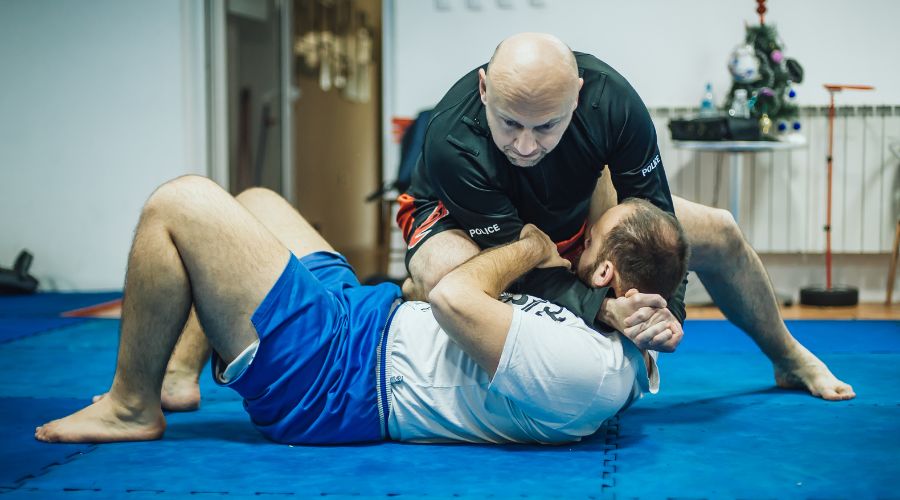BJJ offers infinite ways to subdue, control, injure, or main an opponent, but neck cranks are among the most painful ones and have the potential for long-term damage. This has caused many organizations and rulesets to ban them from competition to guarantee the safety of competitors. But what are neck cranks exactly?
Neck cranks are joint locks that target the neck portion of the spine and create pressure or aim to dislocate the vertebrae. They can be applied from many different positions, and the principles of leverage and using the control points from other joint locks are the same.
Neck cranks may be dangerous, but they are incredibly effective and can make even the toughest person tap. They are essential to grappling and fighting, so it’s best to know what they are and how to apply and deal with them, even if you don’t plan on using them.
What Is A Neck Crank
A neck crank is an attack on the cervical portion of the spine. Unlike air and blood chokes, which also attack the neck, the neck crank aims to put pressure on the vertebrae or bend them in anatomically wrong positions, which is extremely painful and causes the opponent to tap. A neck crank can even target the jaw.
Neck cranks can be performed from various positions and in different ways, some of which we will look at below. The danger with neck cranks is that they are very painful and can lead to severe injuries if held for too long or done with too much pressure. While this makes them deadly effective for real fights, safely applying them in practice is difficult.
This is why neck cranks are illegal in many rulesets and are not practiced at the lower belt levels in most BJJ academies, and only advanced students delve into them once they have enough fundamental skills and control.
Neck Crank vs. Choke

Although neck cranks and chokes also attack the neck, the mechanics differ. Chokes either restrict the airflow by targeting the trachea or the blood flow by compressing the carotid arteries.
On the other hand, cranks are joint locks and use leverage to force one or more of the seven cervical vertebrae into a position where they shouldn’t be. Most neck cranks are achieved through rotational force.
Some neck cranks, like the can opener, are clear and have no choking element. But often, chokes and neck cranks flow from each other, making the separation difficult.
The rear naked choke is a typical blood choke. Still, when the opponent tries to escape it, he usually tries to twist his head and alleviate the pressure on his neck.
This is where a choke is transformed into a crank. Darce chokes also always include some level of cranking of the spine, which is normal.
The reverse can also happen. A neck crank can also be turned into a choke when the opponent tries to escape the crank. But the reverse is more common and can lead to some perfectly legal submissions.
Chokes are much safer, with minimal consequences (if you don’t put someone to sleep and continue choking them), but the same cannot be said about cranks.
Someone more stubborn may fight it and even crank their own head when escaping chokes, so be mindful of what is happening and try to avoid injuring training partners, even if it’s due to their stubbornness.
Are Neck Cranks Legal in BJJ

Neck and spinal cranks are illegal under the IBJJF rules for BJJ, which govern most competitions. Still, some rules, mainly no-gi, allow certain neck cranks. For example, under the ADCC rules, the twister and can opener are legal.
Other competitions, like the EBI and Combat Jiu-Jitsu, place no restrictions on submissions. But competitions with no or few restrictions are almost always reserved for more experienced grapplers, and beginners have no place there.
But why are neck cranks banned in competition? In its pure form, BJJ is a deadly martial art with countless ways to dominate or hurt an opponent.
This was thoroughly proven in no-rules battles in Vale Tudo in Brazil and then in MMA. This brought in legions of fans and people who wanted to learn the art, but not everyone had the heart and body of a fighter.
Gradually, BJJ was changed to reduce the chances of injury in competition and training by banning more techniques.
Like any other martial art, the more rules and restrictions are in place, the more it’s watered down from its original purpose. But the safer environment attracts more and different people, and BJJ would perhaps not be practiced by so many people worldwide if it didn’t make the change.
But in my opinion, regardless of your level and intentions of competing, you should learn how to do and defend neck cranks.
You can choose never to use them, but the knowledge must be there. First, you may grapple against a guy from another style or someone who is into no-gi and uses cranks. It’s much better to understand the danger and defend or tap out in time than to panic and not know what to do.
Furthermore, attacking the neck is vicious and may be useful in self-defense situations. And if you are into MMA, neck cranks are perfectly legal, so you can even use your skills in competition.
Neck Crank Variations
Neck cranks come in many variations and can result from a baldly applied choke or a poorly defended one. But some deliberate and nasty neck cranks are available from plenty of positions and found in a lot of grappling martial arts, even though they are often banned in competition, not just in BJJ.
Neck cranks are usually quite simple but can do a lot of damage, so even if you train them, do it carefully.
Can Opener
Perhaps the most common form of a neck crank is the can opener. It’s simple, painful, and a sure way to get your training partners to hate you and get disqualified from the BJJ competition.
In grappling, it’s used to force an opponent to open his closed guard, but if they stick to the guard, it becomes a submission.
Front Face Lock
The front face lock is another easy-to-perform neck crank. The setup is very similar to a guillotine, but instead of choking, you place your forearm across the opponent’s chin turning his head sideways. The rotational torque is enough to make him tap or destroy his neck.
Neck Crank From Back Mount
The most effective choke from the back mount is the rear naked choke. But the choke can turn into a neck crank when someone defends well with their chin tightly tucked.
The position is the same as the front face lock but from the back. The head goes sideways, pressured by the forearm. The chin serves as the primary leverage point for twisting the neck.
Neck Crank From Mount
The mounted neck crank is another terrible experience for the one experiencing it. From the mount, the hand position is the same as in a rear naked choke, but the “choking” forearm is on the back of the neck, the shoulder presses the chin, and the other hand is on the forehead. Nasty.
Crucifix Neck Crank
In the realm of illegal submissions, the crucifix neck crank is the worst, if I can say that. Even the ADCC, which allows can openers and twisters, has banned the crucifix. This is truly a horrific joint lock because your entire body pressures the neck while the opponent’s hands are trapped and cannot defend.
Twister
The twister is a bit more complicated to set up than most other submissions on the list, but there is no escaping once locked in. The twister is a sideways spine compression and a neck crank simultaneously. It can also cause pain in other parts of the body, depending on the flexibility of the victim. Hence, the twister is a full-on pain package.
And here is an excellent video showcasing some of the techniques in addition to a few more setups:
Summary
Neck cranks are useful in many situations and are often a natural continuation of chokes. So even if you train and compete only under the IBJJF sports version of BJJ, it’s valuable knowledge to know what they are. And if you are into MMA or want to use BJJ for self-defense, neck cranks can become another very effective tool in your arsenal.
